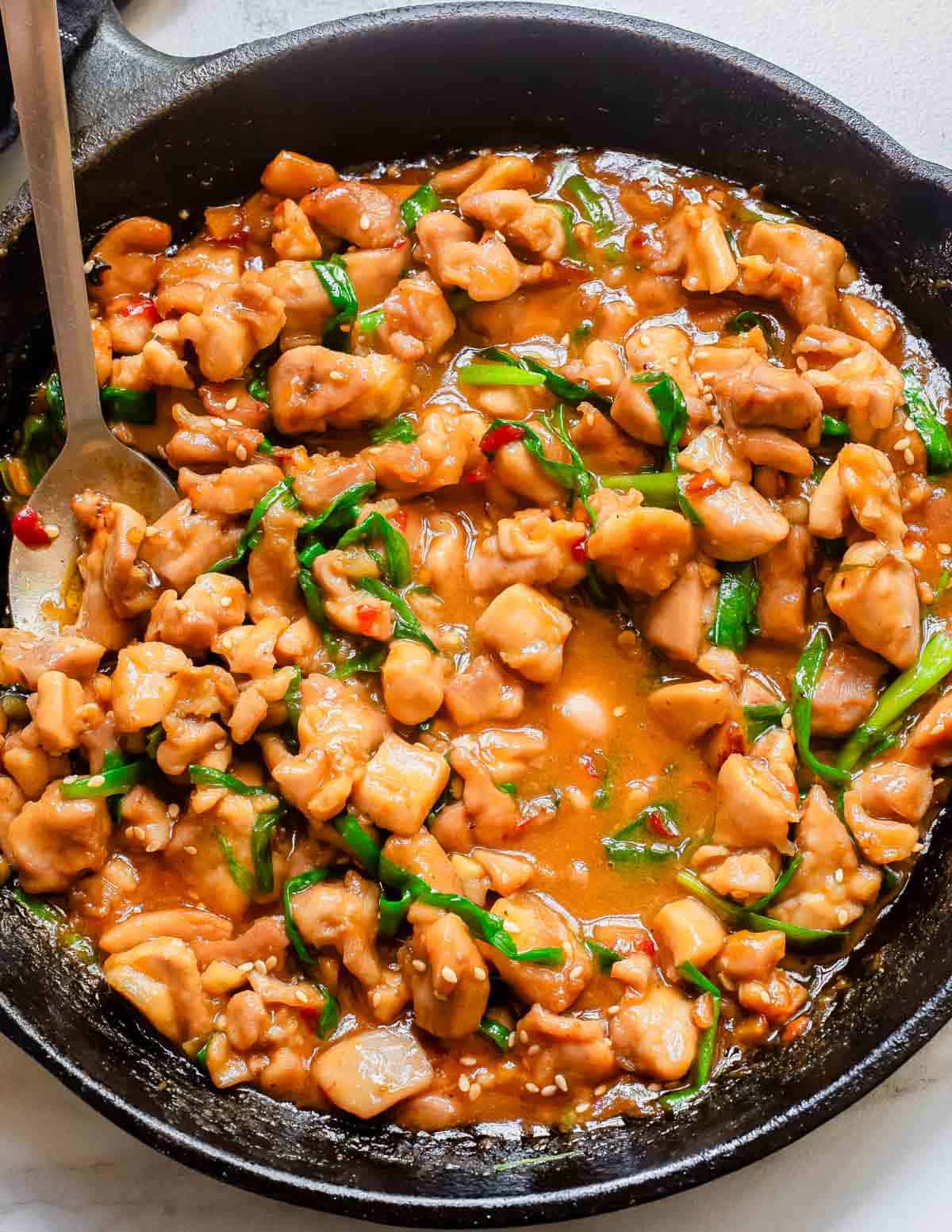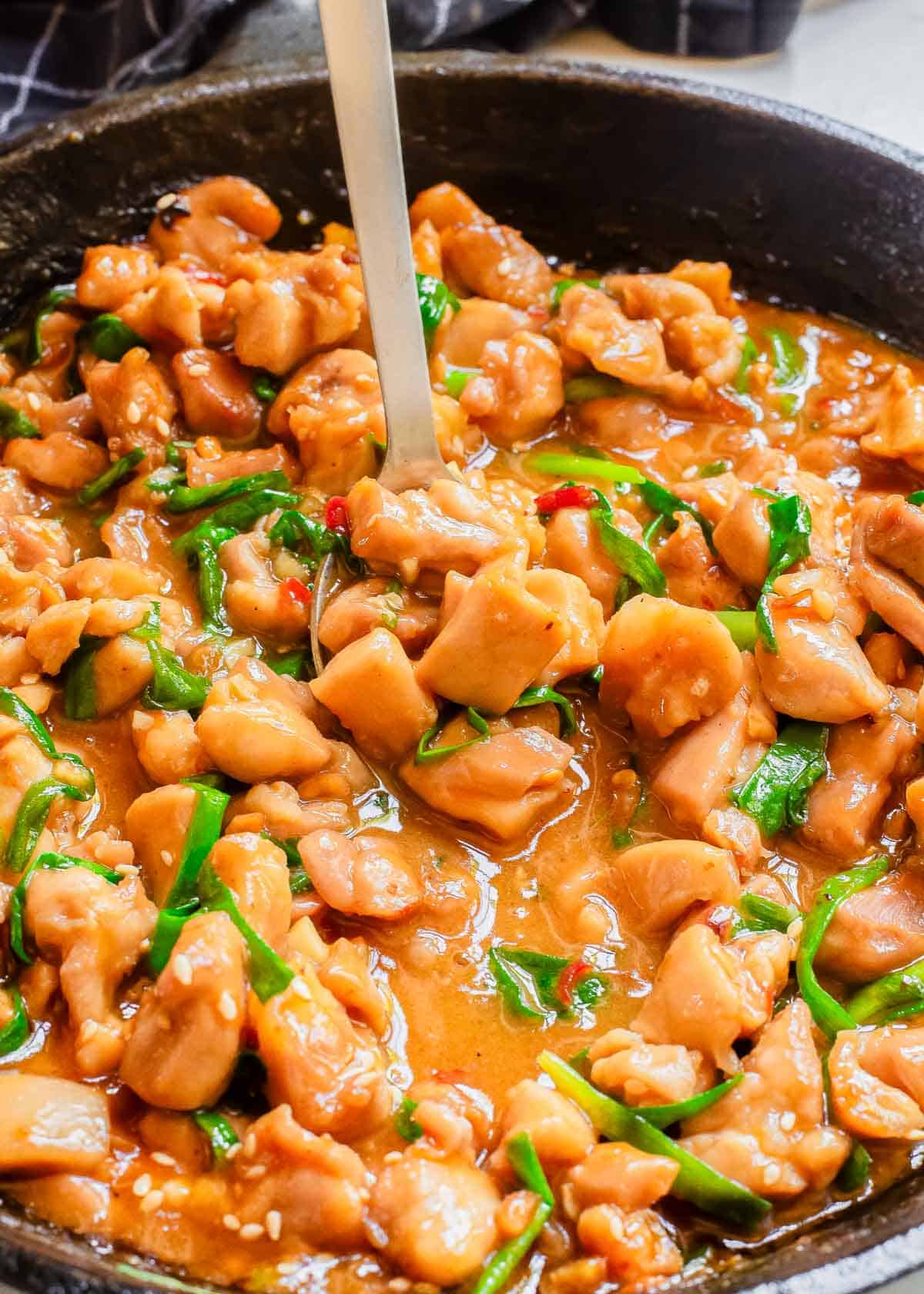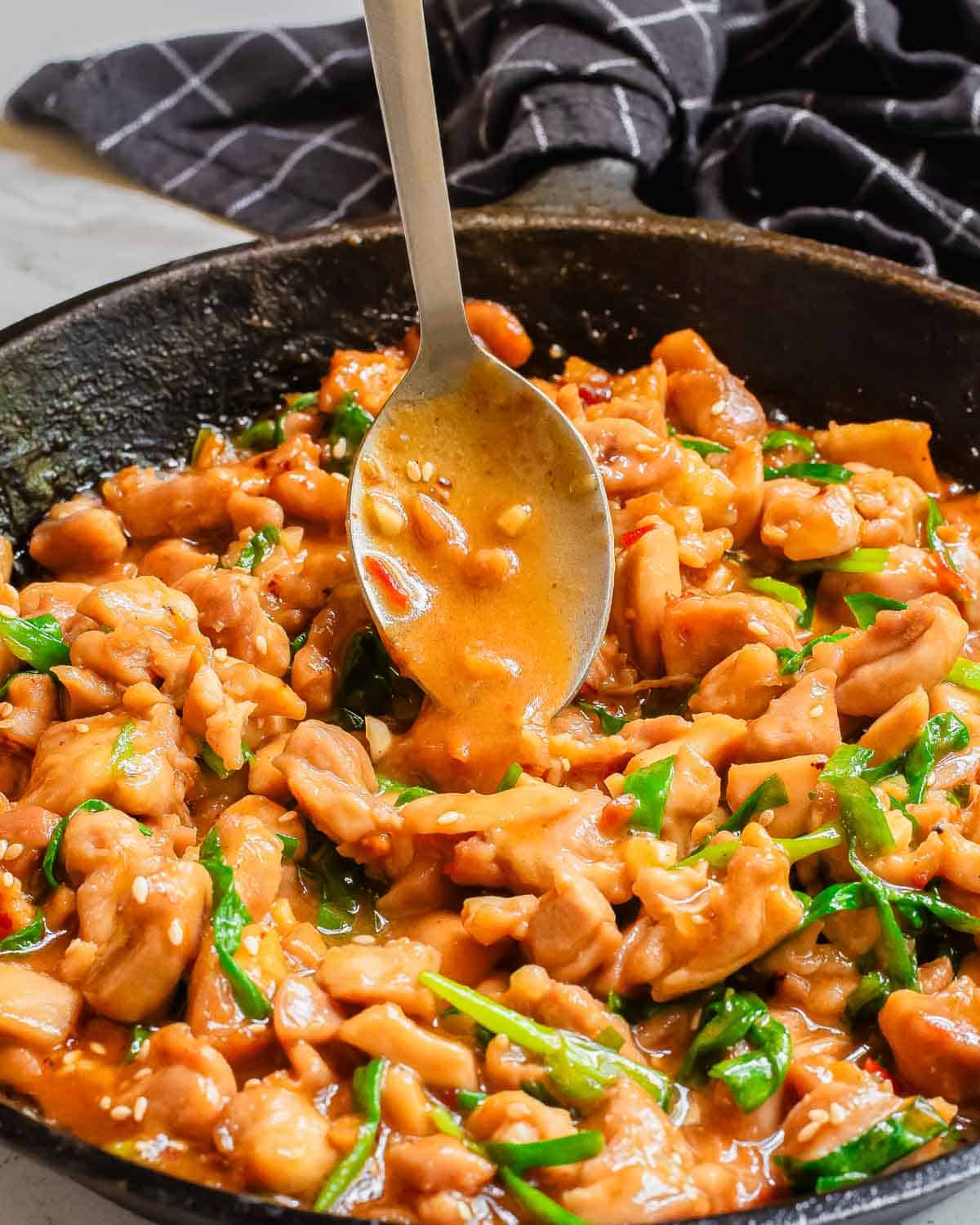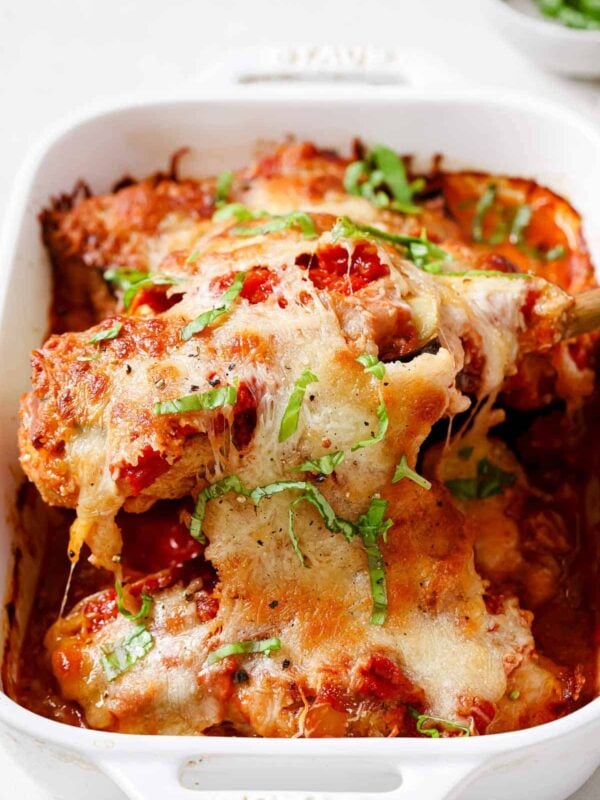This gochujang chicken is a quick 30-minute dinner featuring a takeout-inspired sticky, spicy and sweet sauce that’s perfect served over white rice.

Quick and easy takeout inspired meals are some of my favorite dinners to create at home. They’re often accompanied by some variation of a crave-worthy spicy, sweet and sticky sauce and this gochujang chicken recipe is no different.
In fact, this may be one of the easiest homemade takeout recipes of all. In just 30 minutes, the chicken is marinated and cooked, ready to eat in your bowl.
Gochujang paste wasn’t always something I kept on hand in my refrigerator but after I tried it for the first time, it took up permanent residence and I think you’ll have the same experience once you try this Korean inspired chicken recipe.

Ingredients to make gochujang chicken
- boneless, skinless chicken thighs
- green onions
- gochujang paste
- tamari (soy sauce or coconut aminos can be substituted)
- honey
- garlic
- ginger
- brown sugar
- avocado oil
Chicken thighs — Dark meat chicken offers more flavor due to its higher fat content and results in more tender chicken. Feel free to make gochujang chicken breasts instead but I always prefer thighs to breasts for simple skillet recipes like this. If using breast meat, you can likely reduce the cooking time by 1-2 minutes.
Garlic and ginger — While convenience might tempt you to use jarred, dried or tube versions of either of these ingredients, fresh is really best. This recipe has such limited ingredients, keeping these spices freshly minced offers a bigger flavor impact.
Brown sugar and honey — Both of these sweeteners can be swapped out for similar substitutions like coconut sugar or maple syrup. They’re essential in the sweet offset to the spicy gochujang so don’t skip them.
What is gochujang?
If this is your first encounter with this traditional Korean ingredient, you may be wondering what gochujang is.
Gochujang is fermented red chili paste. It’s savory and spicy with a touch of sweetness and a popular condiment used in Korean cooking. The sweetness comes from the glutinous rice, the spiciness from the gochu-garu (Korean red chili powder) and the savory flavor from the fermented soybeans and salt used to create the paste.
Where to find it
You can typically find gochujang paste in the grocery store nearby wherever miso paste and tofu are sold. It’s usually sold in a large tub. Don’t worry about the size of it because it will keep in the refrigerator for a long time. Once you discover its deliciousness, you’ll be on hunt for all the delicious ways to use it.
What does it taste like?
Gochujang is a bit spicy, a tad funky and very savory while also having undertones of sweet and salty vibes. It’s the ultimate umami taste. Don’t be overly worried about the spiciness. A typical jalapeño pepper is hotter on average than gochujang. Some brands will sell different levels of spiciness so read the labels carefully before buying.

How to make gochujang chicken thighs
The recipe starts out by marinating the chicken thighs in a simple gochujang sauce.
Combine the gochujang paste, honey, tamari, brown sugar, garlic and ginger in a small bowl. Whisk together until smooth. If you need to thin the marinade out a little, simply add a tablespoon or two of water.
Place the chicken pieces in a large bowl, add half the marinade then toss to coat and let sit for 15 minutes to marinate. The chicken can marinate up to a few hours for extra flavor if you’re not in a rush.
Heat the avocado oil in a large skillet over medium heat. Once hot, add the marinated chicken with the sauce and cook for about 6-8 minutes until the chicken is fully cooked through.
Add the green onions and remaining marinade to the skillet. Cook for another 1-2 minutes just until the green onions have wilted and the gochujang sauce is bubbly and starting to thicken and reduce.
Remove from the heat. Garnish with toasted sesame seeds if desired and serve over white rice.
Why you’ll love this Korean inspired chicken recipe
- It’s a 30 minute meal start to finish.
- Just enough spice to satisfy mature palates while still being kid friendly. If spice is still too much for your kids, try this slow cooker honey garlic chicken recipe instead.
- Tender, succulent chicken thighs are juicy and perfectly cooked.
- Has all the effect of takeout food without the cost or unhealthy oils and ingredients.

What’s the best gochujang substitute?
Gochujang is hard to swap out for one single ingredient. The best option to mimic its flavor is a combination of miso paste and sriracha with a touch of honey, maple syrup or brown sugar.
My Pro Tip
Recipe Tip
For every tablespoon of gochujang in a recipe use 1/2 tablespoon of white miso paste, 1/2 tablespoon of sriracha and 1/4 – 1/2 teaspoon of honey (or other sweetener).
What to serve with gochujang chicken
This sweet, savory and spicy chicken dish is complemented really well by anything pickled or tangy in nature.
You can choose from pickled shallots, a creamy cucumber salad with pickled red onions or something more traditional like kimchi. Any homemade fermented vegetables are also perfect alongside the chicken paired with rice.
White or brown rice is the traditional way to serve Korean chicken recipes like this but lower-carb options of cauliflower rice or grilled vegetables like bok choy are also a good choice. Use large bibb lettuce leaves to create a lettuce wrap as another option to enjoy the saucy gochujang chicken.

How to store it
In an air-tight container, the gochujang chicken will store for 4-5 days in the refrigerator. Reheat in the microwave or on the stove top.
The recipe may also be frozen after cooking. Let the chicken come to room temperature, then place in a freezer safe container and freeze for up to one month. Thaw under refrigeration and reheat as described above.
Other variations to try
Like most Asian takeout inspired meals, this recipe can be made with a variety of proteins.
Try making gochujang shrimp by using fresh or thawed frozen large or jumbo shrimp that have been deveined without the tails. General Tso shrimp is another great option if you want a Chinese takeout inspired seafood dish.
If you prefer a plant-based gochujang recipe, swap out the chicken for tofu or chickpeas. Kung pao chickpeas and sweet and sour tofu are two other vegetarian options for similar tasting dinners.
You can also use this marinade on chicken wings or chicken drumsticks. The cooking time will obviously need to be adjusted to each type of chicken but the gochujang marinade and sauce will taste delicious on any of them.

Gochujang can also be eaten as a condiment by itself. For extra umami spiciness, serve this chicken with a side of the paste and dip each forkful.
More takeout inspired quick meals
If this gochujang chicken skillet inspired you to create more quick and easy takeout type meals at home, this ground beef stir fry, shaved beef and broccoli recipe or spicy udon noodle stir fry are all great options.
Don’t miss out on shrimp lo mein or kung pao shrimp either. They’re both quick and easy seafood dinners that will rival any Chinese food restaurant.
If you want another traditional Korean dish, try this Korean sweet potato glass noodle dish also known as japchae.
Gochujang Chicken

Ingredients
- 1 pound boneless, skinless chicken thighs, cut in chunks
- 2 tablespoons gochujang paste
- 2 tablespoons honey
- 2 tablespoons brown sugar
- 4 tablespoons tamari, swap soy sauce or coconut aminos
- 1 tablespoon minced fresh garlic
- 1 tablespoon minced fresh ginger
- 1 tablespoon avocado oil
- 1 cup chopped green onions
- toasted sesame seeds for garnish, *optional
Instructions
- Cut chicken into bite size pieces and add in a large bowl.
- In a small bowl, whisk together the gochujang paste, honey, brown sugar, tamari, garlic and ginger to create the marinade. Pour half of the mixture over the chicken in the bowl. If the marinade is too thick, it can be thinned out with a bit of water. Marinate for 15 minutes.
- Heat the avocado oil in a skillet over medium heat. Add the marinated chicken and cook for about 8 minutes until fully cooked through.
- Add chopped green onions with the other half of marinade sauce. Stir and cook for 1-2 minutes just until the onions soften a bit and the sauce bubbles and thickens.
- Remove from the heat and serve over white rice with toasted sesame seeds if desired.
Nutrition
Nutrition information is automatically calculated, so should only be used as an approximation.
Gina Matsoukas is an AP syndicated writer. She is the founder, photographer and recipe developer of Running to the Kitchen — a food website focused on providing healthy, wholesome recipes using fresh and seasonal ingredients. Her work has been featured in numerous media outlets both digital and print, including MSN, Huffington post, Buzzfeed, Women’s Health and Food Network.















I have been looking for Gochujang but they all say made in a facility that processes wheat. Is there a brand that is actually gluten-free? You have a link above for O’Food Gochujang, which says it is vegan but does not say gluten free. I really want to try it, but…
Your best bet is amazon: https://amzn.to/3OHbHL1
Quick, easy and delicious, this recipe is a go-to if you are craving for some korean. The sweet-spicy kick is perfect over fluffy white rice.
This was the perfect combination of sweet and spicy, so much so that my spice loving husband loved it and it wasn’t too much spice for my kids. Love the sticky sauce and so easy to make quickly.